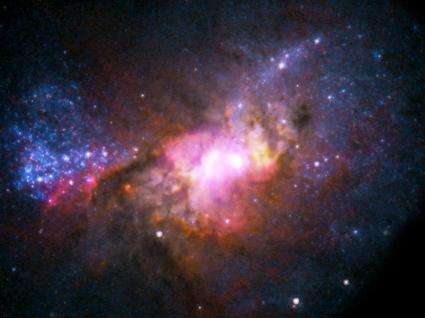Image: The Early Cosmos

(PhysOrg.com) -- Stars are forming in Henize 2-10, a dwarf starburst galaxy located about 30 million light years from Earth, at a prodigious rate, giving the star clusters in this galaxy their blue appearance.
This combination of a burst of star formation and a massive black hole is analogous to conditions in the early Universe.
Since Henize 2-10 does not contain a significant bulge of stars in its center, these results show that supermassive black hole growth may precede the growth of bulges in galaxies.
This differs from the relatively nearby universe where the growth of galaxy bulges and supermassive black holes appears to occur in parallel.
The combined observations from multiple telescopes has provided astronomers with a detailed new look at how galaxy and black hole formation may have occurred in the early universe.
This image shows optical data from the Hubble Space Telescope in red, green and blue, X-ray data from NASA's Chandra X-ray Observatory in purple, and radio data from the National Radio Astronomy Observatory's Very Large Array in yellow.
A compact X-ray source at the center of the galaxy coincides with a radio source, giving evidence for an actively growing supermassive black hole with a mass of about one million times that of the sun.
Provided by JPL/NASA



















